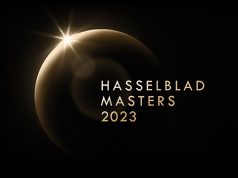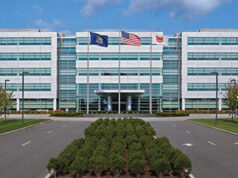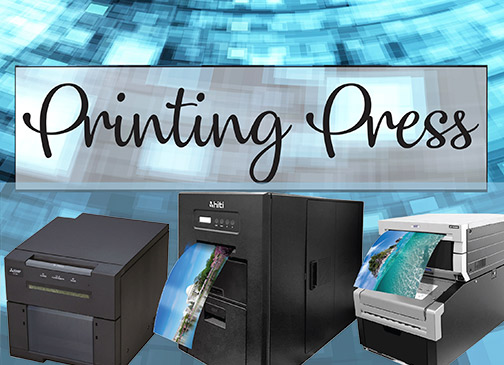
When I started writing for the photo industry back in 1980, the concept of one-hour film processing and printing was just emerging. Chemical-based minilabs like the Noritsu QSS-2 were about to start a revolution in consumer photofinishing. Gradually, dry minilabs, self-serve kiosks as well as portable photo printers began to replace silver halide in retail environments. Wet labs, however, continued to fill the quality and speed requirements in professional photo labs. The result is nearly infinite output options for photographers, labs and retailers.
Noritsu America Corporation
Noritsu is one of the few suppliers still providing chemical minilabs in the United States. “It’s true that for many of our customers the demand for wet labs has diminished due to acquisition and operating costs, plus space requirements,” says Jeff Dunst, Vice President, Sales, Noritsu America. “However, there is still strong demand for these products in the professional market.”
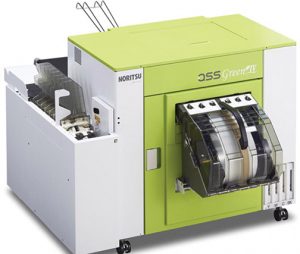
The company introduced two models in 2018: the QSS-3901G and QSS-3904G silver halide printers. Both are upgrades to the Noritsu QSS-38. The 3901G provides the speed to handle large orders (1,480 4×6-inch prints per hour) plus support for a wide variety of industry software and hardware. The 3904G offers the same versatility but pushes productivity to 2,120 4×6 prints per hour. Both systems support various silver halide papers and processing solutions and provide a range of print sizes.
“Noritsu is constantly looking to improve our manufacturing process to exceed customers’ expectations,” says Dunst. “The QSS-3901G and 3904G are the only printers on the market designed to run a new, very thin AgX paper generally used for album page printing. We also updated the electronics and hardware of each series to make the printers as energy efficient as possible.”
QSS Green IV
Noritsu also released the QSS Green IV, the latest addition to its QSS Green series of photo labs. The QQS Green IV is one of four environmentally friendly inkjet printing systems. It has a compact 4.5-sq.-ft. footprint and provides prints with resolutions ranging from 720×720 to 1,440×1,440 dpi. Print sizes range from 5×3.5 to 12×69.2 inches. An optional paper magazine is also available for loading two types of papers at a time.
Like its predecessors, the Green IV works with Noritsu’s EZ-Controller operation software. It includes AccuSmart image-processing technology for correcting images with simple operations.
“Noritsu strives for continuous improvement in our AccuSmart imaging science,” Dunst explains. “We want to make the best pictures possible with the least amount of user input. EZ-Controller has an abundance of built-in features and was recently updated with six output profiles built into the software—three for the AgX ‘wet’ color space and three for our inkjet ‘dry’ color space. Moreover, these allow the operator to set up specific print channels for specific customers or events.”
Fujifilm North America Corporation
Fujifilm offers a full range of photofinishing solutions—from its stand-alone GetPix print stations to wet and dry minilabs for high-volume print production. The Frontier LP5700R is the company’s current, and most popular, CP-49E chemical wet lab. It handles print sizes from 3.5 to 12 inches wide and outputs approximately 2,210 4×6 prints/hour.
“The LP5700R is a proven, reliable and very cost-effective lab system,” says Manny Almeida, Imaging Division president, Fujifilm North America. “Many professional labs, independent photo labs as well as one big-box retailer use Frontier wet minilab equipment; large fulfillment labs generally use high-speed, silver-halide printing equipment such as Imaging Solutions’ FastPrint or WidePrint systems.”
Fujifilm also offers a variety of dry lab solutions—from the compact Fujifilm ASK-300 dye-sub and Frontier-S DX100 inkjet printers to the stand-alone Frontier DL600 and DL650 Pro dry minilabs. The DX100, DL600 and DL650 Pro all incorporate Fujifilm’s five-color Vividia inkjet system.
“Our lab solutions for small photo retailers are well diversified to fit a wide range of volumes and needs at retail,” says Almeida. “When coupled with the Epson P6000 wide-format printer and Xerox Phaser 6270 photo book laser printer, Fujifilm’s lab solutions can help a retailer produce a wide gamut of products from passport photos to canvas, metal and large-format posters and banners, books, calendars and cards.”
Fujifilm also recently introduced an updated retail platform. The GetPix Quick photo kiosk provides customers with prints from mobile devices, without the need for cables or a dedicated app.
Kodak Alaris
Known for its popular Picture Kiosk G20 printing solutions and its contemporary M1 order stations, Kodak Alaris recently added two printers for high-quality photo output. The Kodak 6900 thermal dye-sub photo printer is a high-speed, high-volume upgrade to its 6850 model. It’s designed for use by photo retailers, photographers as well as event imagers. Moreover, the 6900 uses patented thermal panoramic print technology to output 300-dpi prints. It offers a high-quality mode for premium gloss or matte prints and standard mode for faster printing speeds. It’s capable of producing 4×6-inch prints in 8.7 seconds, with a capacity of 750 4×6 prints per cartridge. Print sizes range from 2×6 to 6×20 inches.
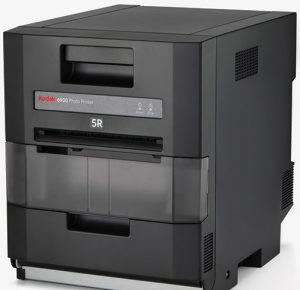
The Kodak DL2200 duplex printer is a single-pass LED electrophotographic printer—upgraded from its predecessor, the DL2100. It is capable of creating premium products such as greeting cards, photo books, calendars as well as Kodak Copy Service products. In addition, the duplex printer includes performance upgrades to optimize photo printing on a variety of substrates; an updated double media tray (a third tray is available); new toners for enhanced color reproduction; and robust fusing characteristics. Print sizes range from 4.8×6.8 to 8.3×11.7 inches at 600 dpi.
APEX Dry Labs
Kodak Alaris also offers a series of Adaptive Picture Exchange (APEX) dry lab systems for volume printing. Available in four configurations, APEX Photo Shops are completely modular. They allow retailers to choose the best Kodak printers and accessories to fulfill customers’ needs. The APEX 30 and 70 are Kodak’s most recent systems. The APEX 30 is ideal for low- to mid-volume printing; the 70 is for mid- to high-volume printing. Both systems function as a lab manager to monitor order status from start to finish.
“Kodak Moments continues to be a leader in photo kiosks and to invest in all areas of our Kodak Moments solutions to enhance the retail ecosystem and user experience,” says Stephen Turberg, director of Current Retail Product Solutions for the Kodak Moments Division. “We offer a high-quality range of photo products that are simple and fast to create and order.”
Epson America Corporation
Best known for its innovative solutions in inkjet printing, Epson recently introduced the SureLab D870. The high-productivity inkjet printer offers small- and medium-format prints. The D870 employs UltraChrome D6r-S dye-based ink technology to output as many as 430 4×6-, 275 5×7- or 140 8×10-inch photos per hour.
“The SureLab D870 is primarily targeted at portrait photographers and then secondarily at retail and event photography applications,” says Reed Hecht, product manager, Epson America Professional Imaging. “There are a few key elements that are improvements over the D700 product that launched last year. They include an easier-to-use media load/unload button; the new quick print mode, dramatically shortening the time to output the first print; a more industrial print engine; a newly redesigned media spindle; and a more robust and configurable output media tray. The D870 also now supports media as small as 3.5 inches wide.”
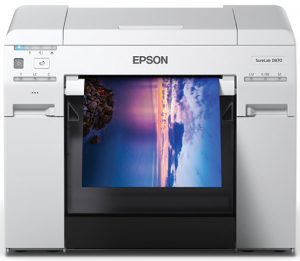
In addition, the D870 employs Epson’s six-color dye-based ink technology to create a wide color gamut for prints that are smudge, water and fade resistant. It prints on an array of photo finishes, including glossy, luster and matte surfaces. It also produces a variety of BorderFree sizes starting at 3.5 inches wide, plus panoramic prints up to 8.3×39 inches. Furthermore, its MicroPiezo AMC printhead and AccuPhoto image-processing and screening technology provide smooth gradations, accurate skin tones and sharp photos, according to Hecht.
“Epson is committed to delivering high-quality photographs,” says Hecht. “Holding a printed photograph entices the senses, brings up emotions and sparks memories. The SureLab D870 was designed to quickly produce photos so families can share and reexperience these moments through printed photos.”
Mitsubishi Electric
Mitsubishi offers several dye-sub printers for location, studio and retail photo output. Its most recent introduction is the compact, high-capacity CP-M1E photo printer. It’s capable of producing dye-sub prints from 3.5×5 to 6×8 inches. The CP-M1E is slightly larger than the company’s top model, the CP-D90DW-P. In addition, it features a simple ink and paper media exchange process that requires only three steps. The CP-M1E also includes Mitsubishi’s rewind function, which returns the ink ribbon to the unused portion when printing 4×6 prints. The printer media produces as many as 750 4×6-inch prints per roll.
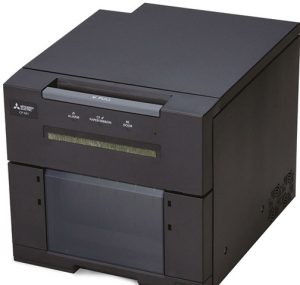
Moreover, the popular CP-D90DW-P provides single-sided prints from 2×6 to 6×20 inches. It is compact (10.8×14.37×9.33 inches) and relatively light weight (30 pounds). And it prints as many as 430 4×6-inch prints per hour. It can also be used with 4×6-inch postcard paper and perforated media.
In addition, Mitsubishi’s CP-W5000DW 8-inch duplex printer is its in-house workhorse, with double-sided printing up to 8×12 inches. It can produce photo books, calendars, greetings cards and other premium products in a variety of formats. The large paper roll capacity allows retailers to print as many as 250 8×12-inch prints.
HiTi Digital, Inc.
HiTi offers multiple high-quality, dye-sublimation commercial printers for imaging output. Models range from compact printers like the P910L and P525L to versatile lab setups like the P530D duplex and X610 high-speed one-pass tandem printer.
The HiTi P910L roll-type photo printer is suited to studio and event photography; it produces 300-dpi resolution prints in sizes from 8×4 to 8×12 inches. It measures 12.95×6.85×15.56 inches and weighs 29.76 pounds. Moreover, the P910L provides jam-free printing at speeds of 35 seconds for an 8×12 print.
The P525L portable printer, also suitable for in-studio and location printing, provides prints ranging from 6×2 to 6×8 inches.

Furthermore, HiTi’s P530D duplex photo printer is for short-run production and customized photo products in a retail, studio or location setting. The P530D prints both single- and double-sided photos, as well as photo books, greeting cards, calendars and other premium products. It prints 6×8-inch double-sided prints in approximately 68 seconds for a glossy double-sided print.
Both the P525L and P530D are recommended for use with the HiTi Mars12 Lite mini kiosk system for on-site studio, event or theme park applications.
The HiTi X610 high-speed one-pass tandem printer is a dye-sublimation minilab solution that outputs 2,000 4×6-inch prints per hour and produces panoramic prints up to 56 inches long. The X610 occupies a small footprint of 3.2 square feet and uses approximately 15% of the power necessary for conventional wet lab equipment. Like HiTi’s other printers, it can integrate with the multifunction, self-service HiTi Libra 220 photo kiosk terminal.
“Energy conservation and carbon reduction have always been the direction of HiTi’s efforts in environmental protection,” according to the company. “Through the revolutionary innovation of photo paper production, the carbon emissions generated in each 4×6 photo paper is less than 3% of previous procedures.”
DNP Imagingcomm America Corporation
DNP provides professional dye-sublimation printers for photo booths, retailers and also professional photographers. The company’s complete lineup includes everything from the IDW500 for passport and visa services to compact dye-sub printers like the DS-RX1HS, DS620A, DS820A and the versatile DS80DX duplex printer.
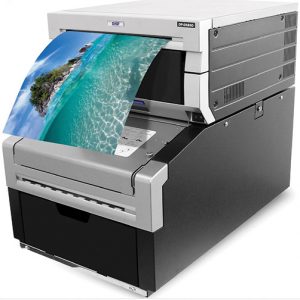
DNP’s flagship printer, the DS620A, is among the most compact models on the market. This makes it suitable for a host of applications—from in-studio and location photography services to small retail store printing. It also offers a range of print sizes from 2×6 to 6×8 inches on gloss, pearl, metallic and sticker media. In addition, it features fast output. It prints standard 4×6-inch images in less than nine seconds and 5x7s in about 15 seconds. The DS620A is lightweight (26.4 pounds) and has a small footprint (10.8×14.4×6.7 inches), allowing for easy transportation and stacking.
Furthermore, the DNP DS80DX is a dye-sub duplex printer that produces everything from greeting cards to portraits. It features dual paper supplies for easy duplex and simplex printing. The duplex printing is a sheet-fed function; it employs a dedicated media tray for double-sided prints such as photo books and calendars. The simplex printing function yields prints from 4×8 to 8×12 inches. Measuring 12.7×19.7×16.4 inches, the DS80DX comes bundled with custom-created software, including mini photo book software for instantly creating compact-sized photo books as well as 4×16 panoramic photo books.


